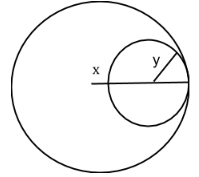
Two circles touch internally. The sum of their areas is \[116\pi cm{}^\text{2}\]and the distance between their centres is 6 cm. Find the radius of circles.
A) 8cm, 20cm
B) 4cm, 10cm
C) 6cm, 8cm
D) 5cm, 9cm
Answer
605.1k+ views
Hint: To solve the question, we have to represent the given data in a diagram which hints the relation between the radius of the circles. Apply relevant formulae to solve the equation and find out the values.
Complete step-by-step answer:
Let the radius of two circles be \[x,y\] where \[x>y\].

The distance between the centre of the circles given = 6 cm.
From the diagram we observe that the distance between the centre of the circles = x - y
\[\Rightarrow x-y=6\] ……. (1)
We know that the formula of area of the circle \[=\pi {{r}^{2}}\]
Where r is the radius of the circle.
Thus, the sum of the areas of the circles with radius x, y \[=\pi {{x}^{2}}+\pi {{y}^{2}}\].
The sum of the areas of the circles given \[=116\pi cm{}^\text{2}\].
\[\Rightarrow \pi {{x}^{2}}+\pi {{y}^{2}}=116\pi cm{}^\text{2}\]
\[\pi \left( {{x}^{2}}+{{y}^{2}} \right)=116\pi \]
\[{{x}^{2}}+{{y}^{2}}=116\]
By substituting the equation (1) in the above equation, we get
\[{{\left( 6+y \right)}^{2}}+{{y}^{2}}=116\] ……. (2)
We know that the formula for \[{{\left( a+b \right)}^{2}}\] is given by \[{{a}^{2}}+{{b}^{2}}+2ab\]
On comparing the expression \[{{\left( a+b \right)}^{2}}\]with \[{{\left( 6+y \right)}^{2}}\], we get a = 6 and b = y
By substituting the above formula in equation (2), we get that
\[{{6}^{2}}+2(6)y+{{y}^{2}}+{{y}^{2}}=116\]
\[36+12y+{{y}^{2}}+{{y}^{2}}=116\]
\[2{{y}^{2}}+12y-116+36=0\]
\[2{{y}^{2}}+12y-80=0\]
\[2\left( {{y}^{2}}+6y-40 \right)=0\]
\[{{y}^{2}}+6y-40=0\]
\[{{y}^{2}}+10y-4y-40=0\]
\[\left( y+10 \right)\left( y-4 \right)=0\]
Thus, the possible values of y = 4 cm, -10 cm.
Radius is a measurement which cannot be negative.
\[\Rightarrow \]y = 4cm
The value of x = 6 + y = 6 + 4 = 10cm.
Thus, the radius of the circles are 4 cm,10 cm.
Hence the option (b) is the correct answer.
Note: The possibility of mistake is the calculations while solving the quadratic equations. The alternative method to solve the question is by option elimination method, from the given information we understand that the difference between the radius of the circles is equal to 6 cm. Thus, we can arrive at the solution while eliminating the other three options.
Complete step-by-step answer:
Let the radius of two circles be \[x,y\] where \[x>y\].

The distance between the centre of the circles given = 6 cm.
From the diagram we observe that the distance between the centre of the circles = x - y
\[\Rightarrow x-y=6\] ……. (1)
We know that the formula of area of the circle \[=\pi {{r}^{2}}\]
Where r is the radius of the circle.
Thus, the sum of the areas of the circles with radius x, y \[=\pi {{x}^{2}}+\pi {{y}^{2}}\].
The sum of the areas of the circles given \[=116\pi cm{}^\text{2}\].
\[\Rightarrow \pi {{x}^{2}}+\pi {{y}^{2}}=116\pi cm{}^\text{2}\]
\[\pi \left( {{x}^{2}}+{{y}^{2}} \right)=116\pi \]
\[{{x}^{2}}+{{y}^{2}}=116\]
By substituting the equation (1) in the above equation, we get
\[{{\left( 6+y \right)}^{2}}+{{y}^{2}}=116\] ……. (2)
We know that the formula for \[{{\left( a+b \right)}^{2}}\] is given by \[{{a}^{2}}+{{b}^{2}}+2ab\]
On comparing the expression \[{{\left( a+b \right)}^{2}}\]with \[{{\left( 6+y \right)}^{2}}\], we get a = 6 and b = y
By substituting the above formula in equation (2), we get that
\[{{6}^{2}}+2(6)y+{{y}^{2}}+{{y}^{2}}=116\]
\[36+12y+{{y}^{2}}+{{y}^{2}}=116\]
\[2{{y}^{2}}+12y-116+36=0\]
\[2{{y}^{2}}+12y-80=0\]
\[2\left( {{y}^{2}}+6y-40 \right)=0\]
\[{{y}^{2}}+6y-40=0\]
\[{{y}^{2}}+10y-4y-40=0\]
\[\left( y+10 \right)\left( y-4 \right)=0\]
Thus, the possible values of y = 4 cm, -10 cm.
Radius is a measurement which cannot be negative.
\[\Rightarrow \]y = 4cm
The value of x = 6 + y = 6 + 4 = 10cm.
Thus, the radius of the circles are 4 cm,10 cm.
Hence the option (b) is the correct answer.
Note: The possibility of mistake is the calculations while solving the quadratic equations. The alternative method to solve the question is by option elimination method, from the given information we understand that the difference between the radius of the circles is equal to 6 cm. Thus, we can arrive at the solution while eliminating the other three options.
Recently Updated Pages
Why are manures considered better than fertilizers class 11 biology CBSE

Find the coordinates of the midpoint of the line segment class 11 maths CBSE

Distinguish between static friction limiting friction class 11 physics CBSE

The Chairman of the constituent Assembly was A Jawaharlal class 11 social science CBSE

The first National Commission on Labour NCL submitted class 11 social science CBSE

Number of all subshell of n + l 7 is A 4 B 5 C 6 D class 11 chemistry CBSE

Trending doubts
What is meant by exothermic and endothermic reactions class 11 chemistry CBSE

10 examples of friction in our daily life

One Metric ton is equal to kg A 10000 B 1000 C 100 class 11 physics CBSE

1 Quintal is equal to a 110 kg b 10 kg c 100kg d 1000 class 11 physics CBSE

Difference Between Prokaryotic Cells and Eukaryotic Cells

What are Quantum numbers Explain the quantum number class 11 chemistry CBSE




